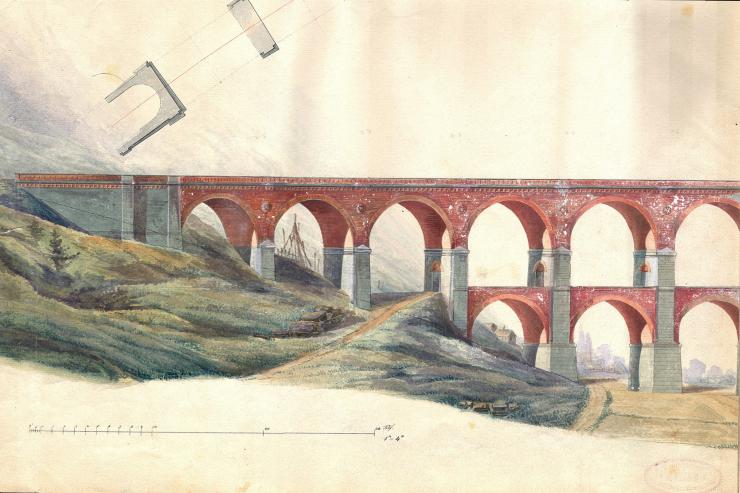
Voda in železnica na Ljubljanskem barju: propad Borovniškega viadukta in njegov nauk za današnji čas
Občina:
Borovnica
Regija:
Osrednjeslovenska regija
Lokacija dogodka:
Osnovna šola dr. Ivana Korošca Borovnica, Paplerjeva ulica 15, 1353 Borovnica
Kontakt za prijave / informacije:
Andrej Klemenc, višji svetovalec za razvoj in razvojne projekte, Občina Borovnica, Paplerjeva 22, 1353 Borovnica, T: 01750 74 68
Spletna stran:
http://www.borovnica.si
Organizator:
Občina Borovnica

OŠ dr. Ivana Korošca Borovnica, Humanistično-umetniško društvo Karel Barjanski, Krajinski park Ljubljansko barje
Čas dogodka
28. 09. 2017, 18.00 - 20.00
Odpiralni čas: 18.00 - 20.00
Event description
On July 27 2017, the world's first railway that has crossed mountains will celebrate 160 years since its completion. It is the famous Vienna – Trieste railway, designed by Carl Ritter von Ghegha, a genius engineer from Venice that managed to remove all technical and political barriers to master the challenge to build a railway across Semmering mountain plateau between Vienna and Graz, across Ljubljana's marshland and hilly, Karst plateau between Borovnica and Trieste, scarce of surface water. Water was of course a condition to run steam powered first trains, thus the largest water pipeline, pumping and storage system of its time was constructed on Karst. On the other side there was too much water on Ljubljana marshes, a true swamp only about half a decade before the construction of the railway started. In order to build the railway the water needed to be drained and loamy marsh soil filled with massive amounts of rocks. On the point where the flat marshland terrain transforms into solid steep Karst edge, Ghegha designed a large Roman aqueduct alike railway viaduct. The viaduct was completed in 1856 and spanned the Borovnica Valley. During its construction and for some decades afterwards it was the largest stone bridge in Europe. The 561 meters (1,841 ft.) long and 38 meters (125 ft.) 24 supported high two-story structure columns built of dressed stone that stood on wooden pilings driven into the loamy marsh soil. Its destiny can tell us a lot about complex and contradictory relations between water and railway. Railways were in a large part built at the dawn of industrial society to overcome shortages of river based inland transport. From one side but collected and transported through pipelines in order to serve steam operated locomotives on the other. On the other side on the flat terrain with high level of underground water the later needed to be drained in order to provide stable foundations and/or to avoid railway to be flooded. For many decades its seems that the cunning of technical reason has won over hidden and mythical power of the water and that engineers has master both shortcoming and overflow of the water. Yet the history of the viaduct give us again an insight into invisible soft power of water. For decades, water had seeped into the Borovnica viaduct, weakening the bricks, and the oak pilings that supported it were beginning to rot due to lack of water in the drained marshland, with the result that the entire structure was gradually settling. Trains crossing it had to slow down to 5 kilometres per hour (3.1 mph). During the World War II, the withdrawing Yugoslav Army blew up part of the bridge; Italian forces replaced the missing part of the viaduct with an iron structure, however increasingly frequent aerial attacks of RAF and USA air forces it in the beginning of 1945 made impossible to repair it. However bombing only masked the true cause of its gradual collapse – the water. The railroad was rerouted to the edge of the Borovnica Valley in 1947, which is where it also runs today. The remaining part of the viaduct was gradually dismantled by 1950. Today only a single column of the viaduct remains, standing in the middle of Borovnica as a commemoration of its past magnificence and the destructive forces of war. Yet should it not stand there to remind us that the water has a silent and invisible power that cannot be mastered by a narrow engineering mind? Even today, many engineers and decision makers are trying to drain the Ljubljana marshes in order to protect it from the flooding. Yet they – and most of the common people – are not aware of the fact that draining of a marshland causes its sedimentation. Therefore, by heavy rainfall we should not be surprised that we are facing ever-increasing floods. The lecture of the director of Ljubljana Marshes Regional Park and presentations of the research on the relations between the water and the railway on Ljubljana Marshes will try to give a new perspective on the remains of the single remaining pillar of Borovnica Viaduct that has a status of a cultural monument of the local importance.
Starostne skupine
Osnovna šola - 3. triada
Dostopnost
Dostopno za slepe in slabovidne
Dostopno za gibalno ovirane
Dogodek je namenjen družinam




